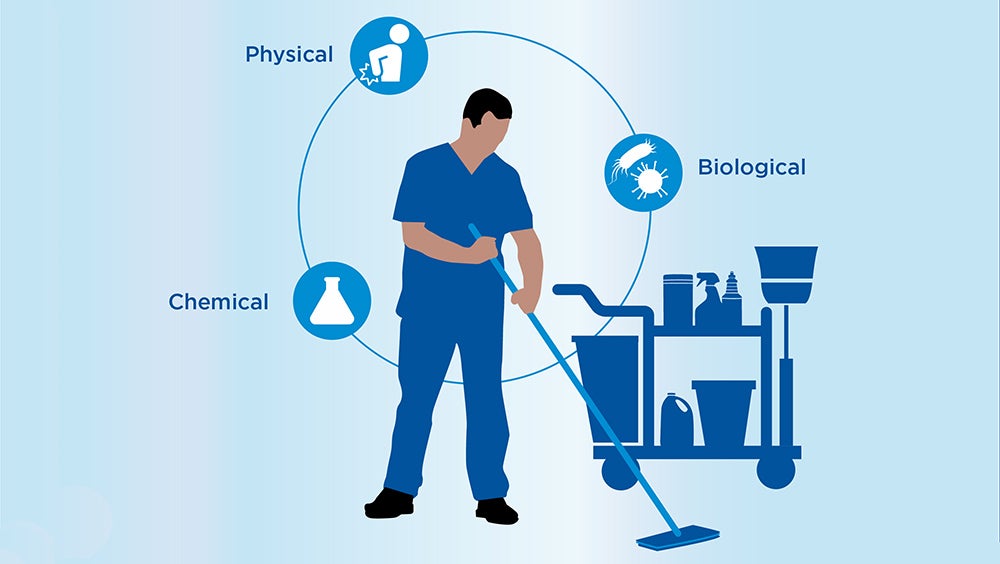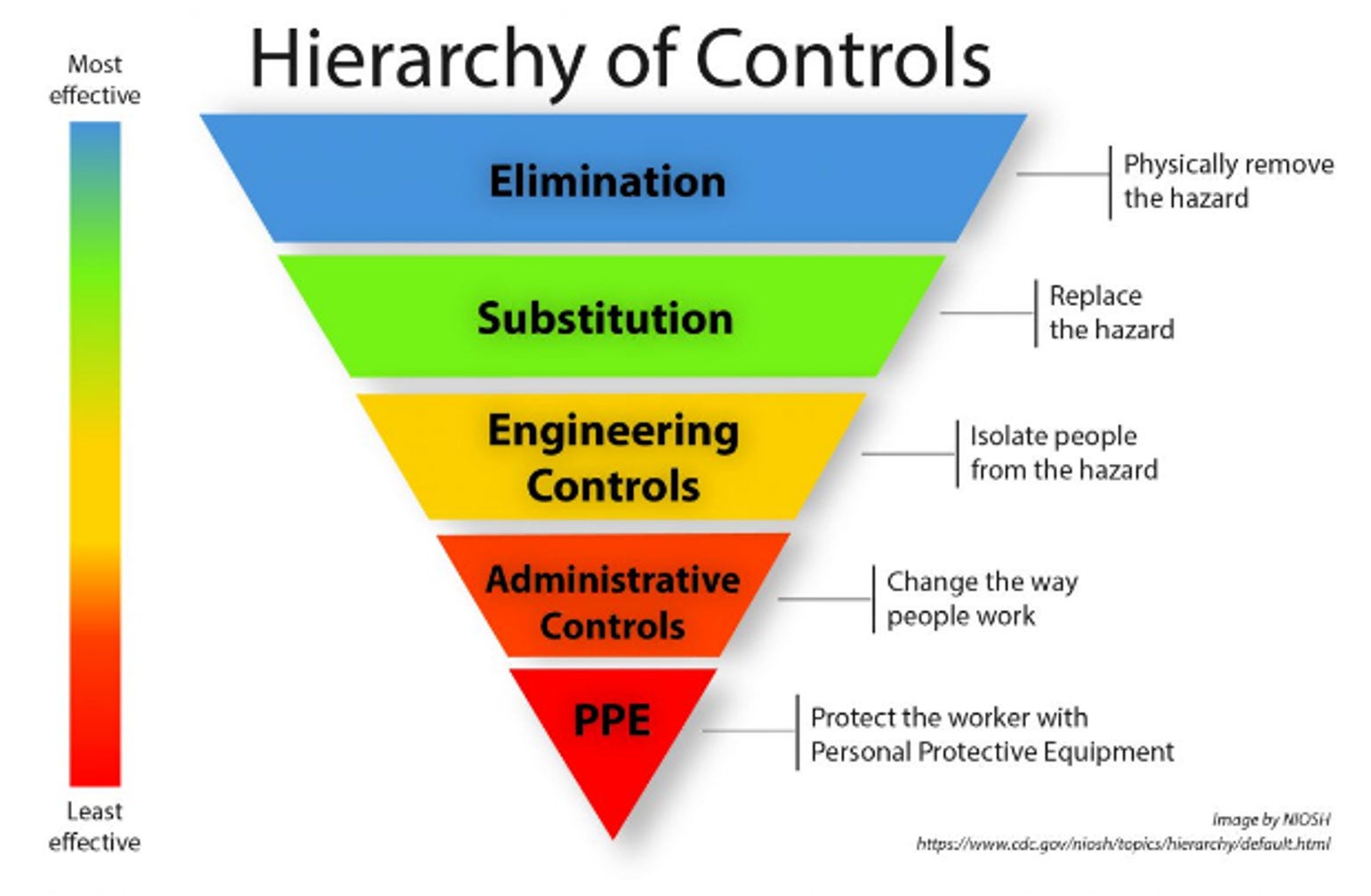
There have been many exciting “aha” moments in my 18 years at Clorox. For example, I distinctly remember the excitement I felt when I learned about the difference between a sanitizer and a disinfectant. It seems silly to say now, but I called home to share something that even my mom, a diehard Clorox bleach user, didn’t know.
Another of these moments happed when I learned about risk assessments. At first, I liked that there was an established method for thinking through risks and how to reduce them…but my excitement grew significantly when I realized how risk assessments can be applied to everyday life! COVID-19 is a real-world example of a situation where a hazard (SARS-CoV-2) was identified along with what could be done to reduce risk (e.g. increasing ventilation, wearing masks, physical distancing, and vaccination).
In the cleaning industry, risk assessments and risk reduction also play a key role to ensuring the safety of frontline cleaners. Janitors and cleaners consistently have high rates of injuries and illnesses that lead to days away from work, so understanding how to do a risk assessment and reduce risk is vital.1,2
Here I break down the process into five easy steps:
Step 1: Understand the definitions
- A hazard is any source of potential damage, harm or adverse health effects on something or someone.3
- A risk, on the other hand, is the chance or probability that a person will be harmed or experience an adverse health effect if exposed to a hazard. It may also apply to situations with property or equipment loss, or harmful effects on the environment.3
- A risk assessment is the overall process used to identify hazards that have the potential to cause harm and evaluate their risk based on potential exposure to those hazards.4
- Risk Reduction are the things that are done to reduce the amount of risk or harm.
Step 2: Identify the hazards
Hazards fall into three main categories5:
- Biological include things like germs, mold, and insects or pests.
- Chemical include things like cleaning products and asbestos.
- Physical include things like slips, trips and falls and faulty or poorly designed tools and equipment.
Step 3: Identify the risks
Next assign a “level of risk” to each hazard based on the expected exposure for employees and what type of injury or illness could result from those exposures. In other words, risk is based on the likelihood that an exposure will occur as well and the expected outcome because of the exposure. For example, any hazard that could result in death or is irreversible and would be something that an employee would be commonly exposed to, would be considered a high risk. Risks are often identified as high, medium, and low.
Step 4: Apply OSHA’s Hierarchy of Controls
In the workplace, once the risk assessment is complete, OSHA suggests using the hierarchy of controls to reduce the risk of any hazard where there is a chance of injury or illness. The hierarchy of controls is a tool that can be used to determine what actions to take. Starting at the top, it is always best to eliminate the hazard if possible. If that isn’t possible, then substitution is the next best option. From there, engineering controls, administrative controls, and PPE should be considered.6,7 Note that education and training help to reduce risk for frontline cleaners and should be part of every operation’s risk reduction strategy.
Here is an example of what this could look like for a cleaning operation:
| Hazard Type | Hazard | Risk of Injury or Illness (because of expected exposure) | Risk Reduction |
|---|---|---|---|
| Biological | Germs spread in the air (droplet): (e.g., Cold, Flu, Covid) | Infectious respiratory illness: Medium | • Increase air filtration • Wear mask • Consistently and properly clean and disinfect high touch surfaces |
| Germs spread on surfaces: (e.g., Staph, Norovirus) | • Skin infections • Infectious vomiting and/or diarrhea: Medium |
• Consistently and properly clean and disinfect high-touch surfaces • Select disinfectants with kill claims for germs of concern • Wear gloves |
|
| Bloodborne pathogens (e.g., HIV, HBV) | Bloodborne infections: High | • Wear gloves (at minimum) • HBV vaccination |
|
| Chemical | Corrosive disinfectant (EPA Cat I) | Chemical burns on skin and eyes: High | • Follow Directions for use • Wear appropriate PPE • Swap out product for one that does not require the use of PPE (EPA Cat III & IV) |
| Physical | Heavy upright vacuum | Musculoskeletal injury: High | Swap out for backpack vacuum |
| Repetitive motion when mopping large spaces | Repetitive motion injury: High | • Use microfiber mop head over cotton mop • Purchase auto floor scrubber |
“Education and training help to reduce risk for frontline cleaners and should be part of every operation’s risk reduction strategy. “
Step 5: Combine the results, write down the plan, and act!
As a final step, look across the results and develop a plan. Consider all risk reduction measures. In some cases, a step to reduce risk is needed for one hazard, but not for another. For example, when it comes to wearing gloves, even when not needed to prevent exposure to the product itself, they should be worn to protect frontline cleaners from exposure to germs and other hazards while doing cleaning and disinfecting tasks.
“When it comes to wearing gloves, even when not needed to prevent exposure to the product itself, they should be worn to protect frontline cleaners from exposure to germs and other hazards while doing cleaning and disinfecting tasks.“
Write down the plan and act by clearly communicating the outcomes to employees. This will ensure they know what the job entails, what you are doing to reduce risks, and what they are expected to do as well. To help manage any next steps that are not immediately actionable, address those with the highest risk first. An added benefit of writing things down is that it will help meet OSHA’s requirements. Revisit your facilities risk assessment on an annual basis and when things change.
What other “aha” moments would you like to her about? Reach out at lori.strazdas@clorox.com and let me know!
References
1. U.S. Bureau of Labor Statistics. Nonfatal Occupational Injuries and Illnesses Requiring Days away from Work, 2015 [Internet]. News Release [cited 2022 Sept 10]. Available from: https://www.bls.gov/news.release/pdf/osh2.pdf
2. U.S. Bureau of Labor Statistics. Occupation Snapshot Janitors and cleaners, 2015-2019 [Internet]. Injuries, Illnesses, and Fatalities. [cited 2022 Sept 10]. Available from: https://www.bls.gov/iif/oshwc/case/osn-janitors-2015-19.htm
3. Canadian Centre for Occupational Health and Safety. Hazard and Risk [Internet]. OSH Answers Fact Sheets [cited 2022 Sept 14]. Available from: https://www.ccohs.ca/oshanswers/hsprograms/hazard_risk.html
4. Canadian Centre for Occupational Health and Safety. Risk Assessment [Internet]. OSH Answers Fact Sheets [cited 2022 Sept 14]. Available from: https://www.ccohs.ca/oshanswers/hsprograms/risk_assessment.html#:~:text=Risk%20assessment%20is%20a%20term,analysis%2C%20and%20risk%20evaluation
5. Gislason E. National Association of Safety Professionals. Dec 2018 Newsletter [Internet]. Types of Hazards [cited 2022 Sept 9]: Available from: https://naspweb.com/blog/types-of-hazards/
6. Health and Safety Executive. Risk Assessment [Internet]. Managing risk and risk assessments at work [cited 2022 Sept 10] Available from: https://www.hse.gov.uk/simple-health-safety/risk/index.htm







